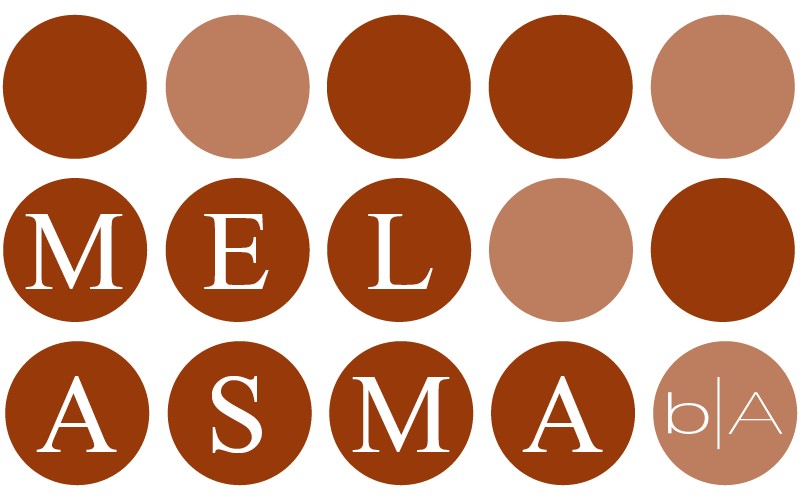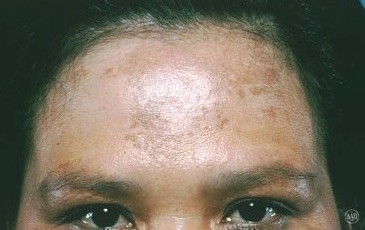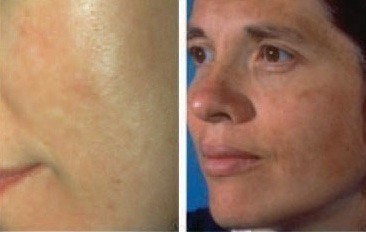
Hyperpigmentation (a fancy word for dark spots on the skin) is one of the main complaints we hear in the professional skin care business. Melasma is often the culprit of hyperpigmentation and can classically be seen on the forehead, cheeks, nose, chin and upper lip. It is medically benign but people who suffer from Melasma are sometimes embarrassed by the dark splotchiness and feel like they can’t leave the house without a lot of make-up on their face. Unfortunately, there is no known cure BUT there are treatments that can help lighten Melasma and help you feel more comfortable in your skin.

What’s happening to cause Melasma? Hormones stimulate the overproduction of melanocytes (the cells that make brown pigment) and then sun/heat exposure activate the melanocytes making melanin, which is brown pigment. That’s why people who suffer from Melasma tend to notice worsening pigment in the summer or other times they have increased sun exposure.
There are three types of Melasma:
- Epidermal
- Dermal
- Mixed
The epidermal type is most common and is identified by the presence of excess melanin on the superficial layer of the skin. Since the pigment is located in the epidermis, this type is easiest to treat. In the dermal type, pigment is sandwiched in between the top layer of skin (epidermis) and the subcutaneous tissue in the dermis, making it more difficult to adequately treat. The mixed type involves the combination of the dermal and the epidermal types.
Melasma is most common in pre-menopausal women ages 20 to 50 and is thought to be triggered by surges in certain hormones as well as heat and/or sun exposure. When it occurs during pregnancy, it is often referred to as cholasma or “pregnancy mask.” While the exact cause is still unknown, there are treatments that can help lessen the effects of Melasma. When treating Melasma, it is important to remember the 3 P’s: Patience, Persistence & Precaution.

Preventive Measures & Treatments for Melasma
- All sunscreens are not created equally. It’s so important to use a sunscreen with at least SPF 30 that not only protects against UVA and UVB rays, but also protects against longer IR waves because Melasma is activated by these waves in particular. We recommend using sunblock that contains physical blockers such as zinc oxide and titanium dioxide for UVA/UVB coverage as well as mineral physical protectors for IR waves. Epionce Tinted Sunscreen is an absolute must for all of my Melasma patients because not only does it meet all of the above requirements, it’s also organic, paraben free, and feels great!
- Topical depigmenting agents, such as hydroquinone, kojic acid, azelaic acid, arbutin, and licorice extract are useful to assist in lightening pigment and are often used pre-procedure to create a healthier epidermis. Hydroquinone is probably the most commonly used skin lightening cream as it is generally effective in decreasing pigmentation by suppressing tyrosinase production (Tyrosinase is the enzyme needed to make melanin). However, it should be used under supervision and direction of a medical professional due to potential for rebound hyperpigmentation called onchronosis if used incorrectly or for too long. I will usually start patients with hydroquinone and transition to products that are better for Melasma skin longterm.
- Retinoids are topical products derived from vitamin A that suppress tyrisonase activity while also creating cellular turnover. Faster cell turnover helps to lift the hyperpigmented cells out of the skin. an acid that increases skin cell (keratinocyte) turnover.
- Microneedling. The wonder treatment. This has been a staple treatment for various skin problems for some time now but recent research is showing it’s propensity to treat Melasma as well. Although the exact pathophysiology of how microneedling helps with hyperpigmentation is not completely understood, the assumption is that with controlled injury to the skin creates cellular modifications necessary to lighten skin. To read an interesting article from the National Library of Medicine, click here.
- Chemical peels such as TCA, glycolic, and VI Peels can help all types of Melasma depending on the strength of the peel. For the epidermal type, sometimes a series of light to moderate peels in conjunction with light microdermabrasion may be enough to lighten the hyperpigmentation. However, with dermal or mixed types, a much stronger chemical peel is necessary to reach the pigment in the dermis. There is risk involved with stronger chemical peels, such as darkening of pigment. We recommend a series of VI Peels as it’s one of the few peels that is able to penetrate to the dermis with low risk of making hyperpigmentation worse.
- Dermasweep combination therapies are excellent for epidermal and mixed types of Melasma. Two different infusion solutions are layered on top of one another to create the right amount of exfoliation and penetration of skin lightening products. Generally, patients will need 6 treatments spaced 2 weeks apart followed by maintenance treatments as needed.
- Certain laser treatments like Fraxel or Fractional CO2 are used to treat melasma. IPL laser treatments should be used with CAUTION. Some places offer “mini IPL” or “low level IPL” for Melasma which may be beneficial for epidermal melasma, but buyer beware as IPL treatments can cause hyperpigmentation to no longer respond to any treatments.
Melasma is an inconvenient thing to deal with but we are here to help find the solution that is right for you.
